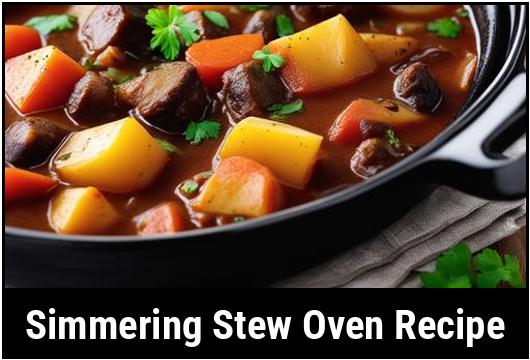
Simmering Stew: The Ultimate Oven Recipe Guide
Welcome to the comprehensive guide on mastering the art of creating a simmering stew using your oven! This mouthwatering creation is a comforting and hearty dish that will satisfy even the pickiest of eaters. In this article, we will delve into the food science behind simmering stews, explore culinary details, provide tips on selection, cleaning, and preparation, share various recipe variations, and even guide you on doneness checks. Get ready to embark on a culinary journey full of flavors and aromas!
The Science Behind Simmering Stews
To truly understand the beauty of a simmering stew, let’s take a closer look at the science behind it. Simmering is a cooking technique that involves gently cooking food in liquid at a temperature just below boiling point. The slow and low heat helps break down the connective tissues in tough cuts of meat, resulting in tender, succulent bites. Additionally, simmering allows flavors to intensify and meld together, creating a harmonious culinary experience.
Culinary Details: Perfecting Your Stew
When it comes to creating a flavorful and satisfying simmering stew, attention to culinary details is key. Let’s delve into some essential factors that will elevate your stew from good to extraordinary:
Selection of Ingredients
Choosing the right ingredients lays the foundation for a delicious stew. Opt for tougher cuts of meat, such as chuck roast or lamb shanks, as they are well-suited for long cooking times. These cuts are rich in connective tissue and collagen, which will break down during the simmering process, resulting in melt-in-your-mouth goodness. For vegetarians or those seeking a lighter option, hearty vegetables like potatoes, carrots, and mushrooms work wonders.
Cleaning and Preparing Ingredients
Before diving into the preparation process, ensure that your ingredients are clean and ready. Trim any excess fat from the meat, and if using vegetables, wash and chop them according to your desired size. It’s important to create uniform pieces to ensure even cooking.
Flavorful Marinades and Seasonings
To impart depth and complexity into your stew, consider marinating your meat beforehand. A simple marinade consisting of herbs, garlic, onion, and a splash of Worcestershire sauce can work wonders. Also, take advantage of seasonings like smoked paprika, thyme, rosemary, or bay leaves, as they add a delightful aromatic touch. Don’t be afraid to explore various spice combinations that resonate with your taste buds.
The Searing Process
Though not mandatory, searing your meat before stewing it can enhance the flavors and create a beautiful caramelized crust. Searing locks in moisture and adds a richness to the dish. Heat a large skillet or cast-iron pan over high heat, add a small amount of oil, and sear the meat until it achieves a golden-brown color. Remember, it doesn’t need to be fully cooked during this step—it’s all about adding that extra layer of flavor.
Oven Simmering Stew: Step-by-Step
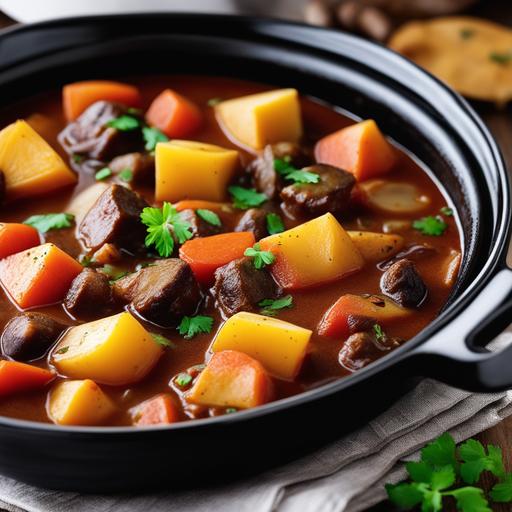
Now that we’ve covered the culinary basics, let’s dive into the step-by-step process of creating a mesmerizing simmering stew using your oven.
Ingredients:
-
2 pounds of chuck roast, cut into 1-inch cubes
-
1 tablespoon of oil (vegetable, olive, or any oil of your preference)
-
1 large onion, diced
-
3 cloves of garlic, minced
-
2 large carrots, peeled and chopped
-
2 celery stalks, chopped
-
8 small potatoes, quartered
-
1 cup of red wine (optional)
-
4 cups of beef or vegetable broth
-
2 tablespoons of tomato paste
-
2 bay leaves
-
1 teaspoon of smoked paprika
-
Salt and pepper, to taste
Instructions:
-
Preheat your oven to 325°F (163°C).
-
In a large oven-safe pot or Dutch oven, heat the oil over medium-high heat. Add the diced onions and minced garlic, sautéing until fragrant and translucent.
-
Add the cubed chuck roast to the pot, allowing it to sear on all sides to develop a rich crust. Remove the meat and set it aside for now.
-
Lower the heat to medium and add the carrots and celery to the pot. Sauté them for a few minutes until slightly softened.
-
Return the seared meat to the pot, and pour in the red wine (if using). Allow it to simmer for a couple of minutes, stirring occasionally.
-
Add the tomato paste, paprika, bay leaves, salt, and pepper to the pot. Stir everything together to coat the ingredients evenly.
-
Pour in the beef or vegetable broth, ensuring that it covers all the ingredients. If necessary, add additional water to ensure proper liquid coverage.
-
Place the pot, covered, into the preheated oven. Let the stew simmer gently for 2 to 3 hours, or until the meat becomes tender and flavors meld together beautifully.
-
After the desired cook time is reached, remove the pot from the oven. Taste the stew, adjusting the seasoning as needed.
-
Serve your simmering stew in a deep bowl, garnishing it with chopped fresh parsley or a sprig of thyme. Pair it with crusty bread or fluffy rice for a complete dining experience.
Tips for Perfecting Your Simmering Stew
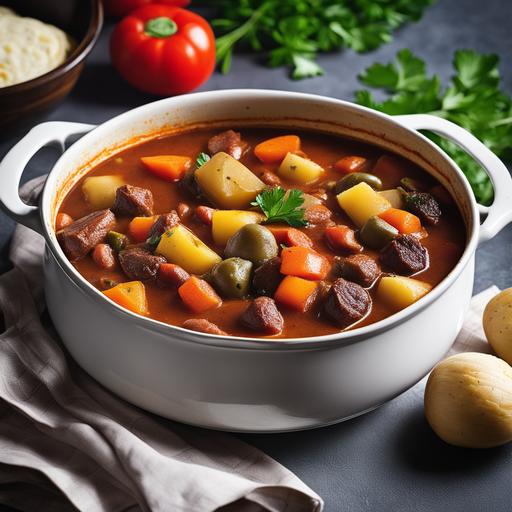
To help you elevate your simmering stew game, here are some additional tips to keep in mind:
-
Experiment with different cuts of meat: While chuck roast is a classic choice, don’t hesitate to explore options like beef shank, short ribs, or pork shoulder. Each cut offers unique flavors and textures.
-
Enhance flavors with umami-rich ingredients: Adding umami boosters like soy sauce, Worcestershire sauce, or a splash of red wine can deepen the savory notes of your stew.
-
Let it rest: Allowing your stew to rest for 10-15 minutes before serving allows the flavors to further develop. Resting also enables the sauce to thicken slightly, resulting in a more cohesive dish.
Recipe Variations to Savor
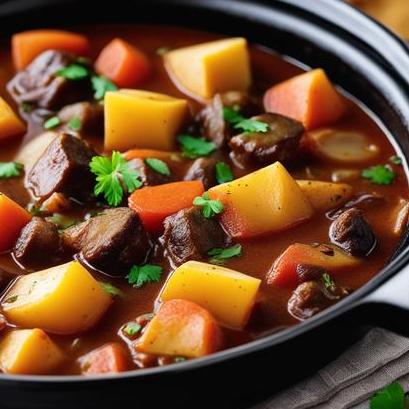
Diversity is the spice of life, and the same applies to simmering stews. Here are a few delicious variations to inspire you:
Mediterranean Lamb Stew
-
Replace the chuck roast with boneless lamb shoulder or leg.
-
Enhance the Mediterranean flavors by adding kalamata olives, sun-dried tomatoes, and a sprinkle of oregano.
-
Serve with couscous or warm pita bread for an authentic touch.
Vegetarian Stew
-
Skip the meat altogether and focus on hearty vegetables.
-
Use vegetable broth instead of beef broth.
-
Experiment with different legumes like chickpeas or lentils to add protein and substance to the stew.
Spicy Southwestern Stew
-
Swap smoked paprika for chili powder.
-
Add diced green chilies, corn kernels, and black beans for a Tex-Mex twist.
-
Top with shredded cheddar cheese, chopped cilantro, and a dollop of sour cream.
Doneness Checks: When is Your Stew Ready?
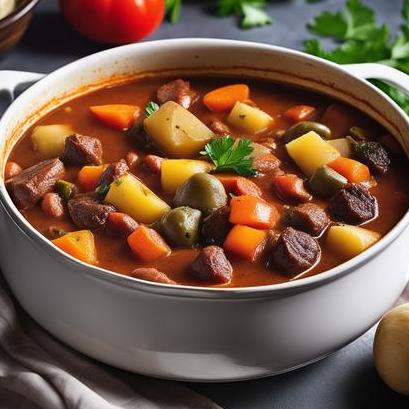
Determining the perfect doneness of your simmering stew can be a challenge, but here are some key indicators to look out for:
-
Meat tenderness: If using meat, it should easily fall apart with a fork. This indicates that the connective tissues have fully broken down, resulting in a tender and melt-in-your-mouth experience.
-
Vegetable softness: Your vegetables should be cooked through but still retain some texture. Overcooking them can lead to mushiness, while undercooking may result in an unappetizing crunch.
-
Flavor balance: Taste your stew throughout the simmering process. The flavors should meld together harmoniously, with no overpowering spices or excessive saltiness. Adjust seasoning if needed.
Conclusion
Congratulations! You’re now equipped with a bounty of knowledge to embark on your simmering stew adventure. We explored the science behind this culinary masterpiece, delved into culinary details, discussed ingredient selection, cleaning, and preparation, shared expert tips, and guided you through a delicious recipe. Whether you choose a classic, Mediterranean, vegetarian, or spicy variation, may your simmering stew always bring comfort, joy, and flavorful satisfaction. Happy cooking!
Sources
FAQS On Simmering Stew Oven Recipe
What Is Simmering Stew And Why Is It Cooked In The Oven?
Simmering stew is a slow-cooked dish made with tender meat and vegetables in a flavorful broth. Cooking it in the oven ensures that the stew is cooked evenly and allows the flavors to blend together for an irresistibly delicious result.
What Type Of Meat Is Best For A Simmering Stew?
Tough cuts of meat, such as beef chuck or lamb shanks, are ideal for simmering stews. These cuts have a higher fat content and connective tissue, which break down during the long cooking process, resulting in tender and flavorful meat.
How Long Should A Simmering Stew Be Cooked In The Oven?
The cooking time for a simmering stew in the oven typically ranges from 2 to 3 hours. This slow cooking process allows the meat to become tender and the flavors to develop fully. However, cooking times may vary depending on the recipe and the size of the meat pieces, so it’s recommended to check for doneness periodically.
Can I Make A Simmering Stew Ahead Of Time And Reheat It Later?
Absolutely! In fact, many people argue that simmering stews taste even better the next day as the flavors have time to meld together. Once the stew is cooked, allow it to cool, and store it in airtight containers in the refrigerator. When reheating, make sure to heat it thoroughly to ensure food safety.
Can I Add Additional Vegetables To The Simmering Stew Recipe?
Certainly! Simmering stews are incredibly versatile, allowing you to customize them according to your preference. Along with the traditional carrots, potatoes, and onions, you can add other vegetables like mushrooms, peas, celery, or bell peppers. Just make sure to adjust the cooking time accordingly to ensure all the vegetables are cooked to your desired tenderness.


